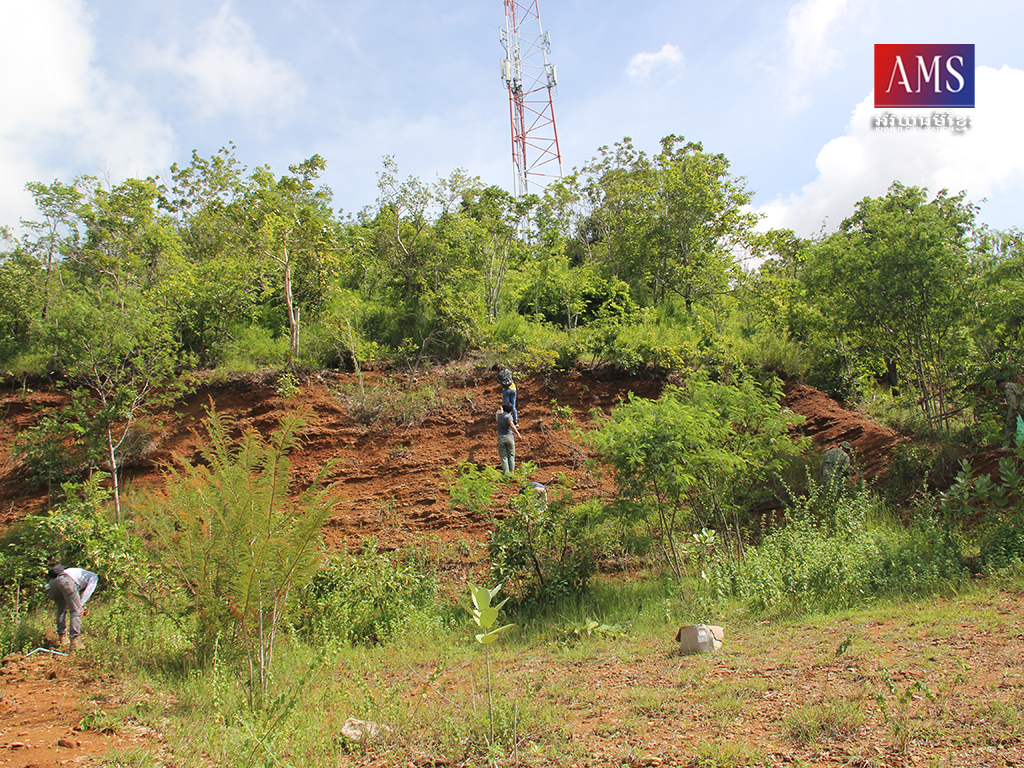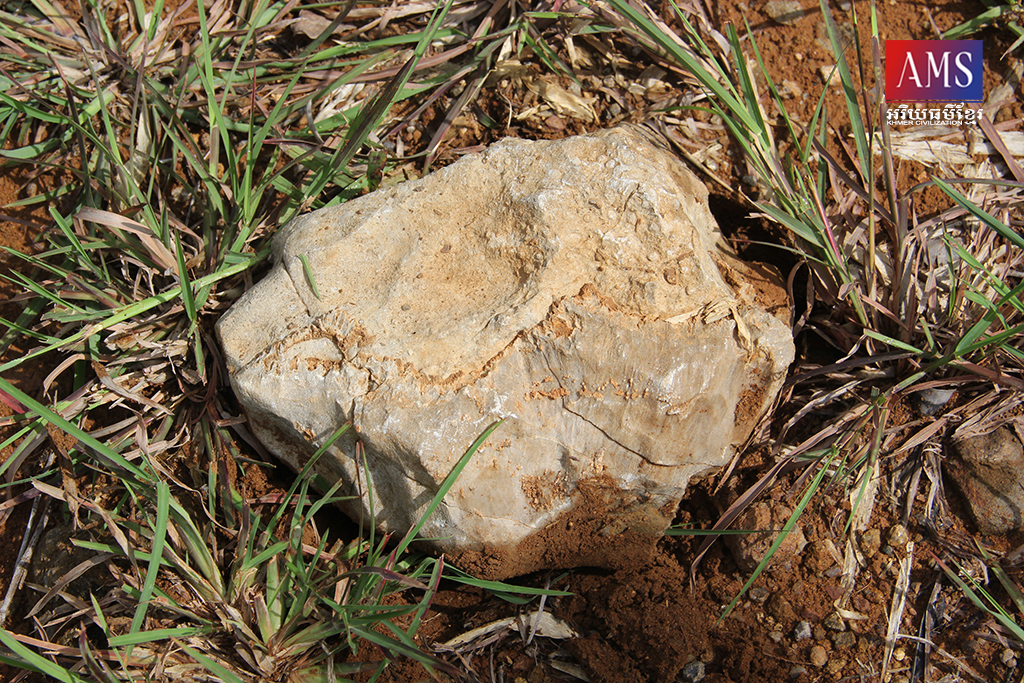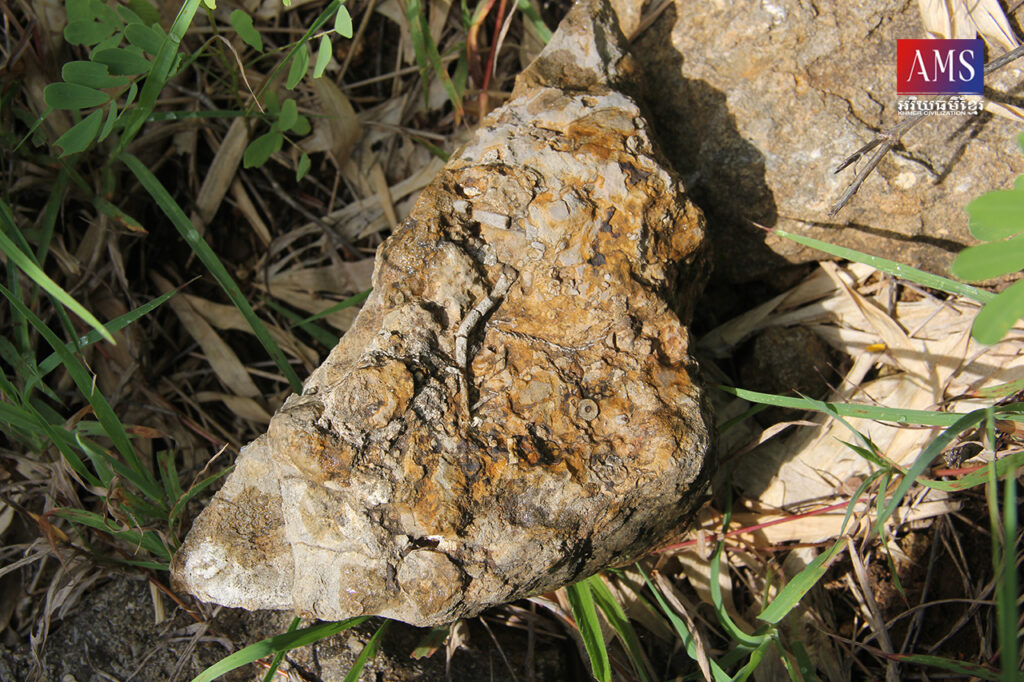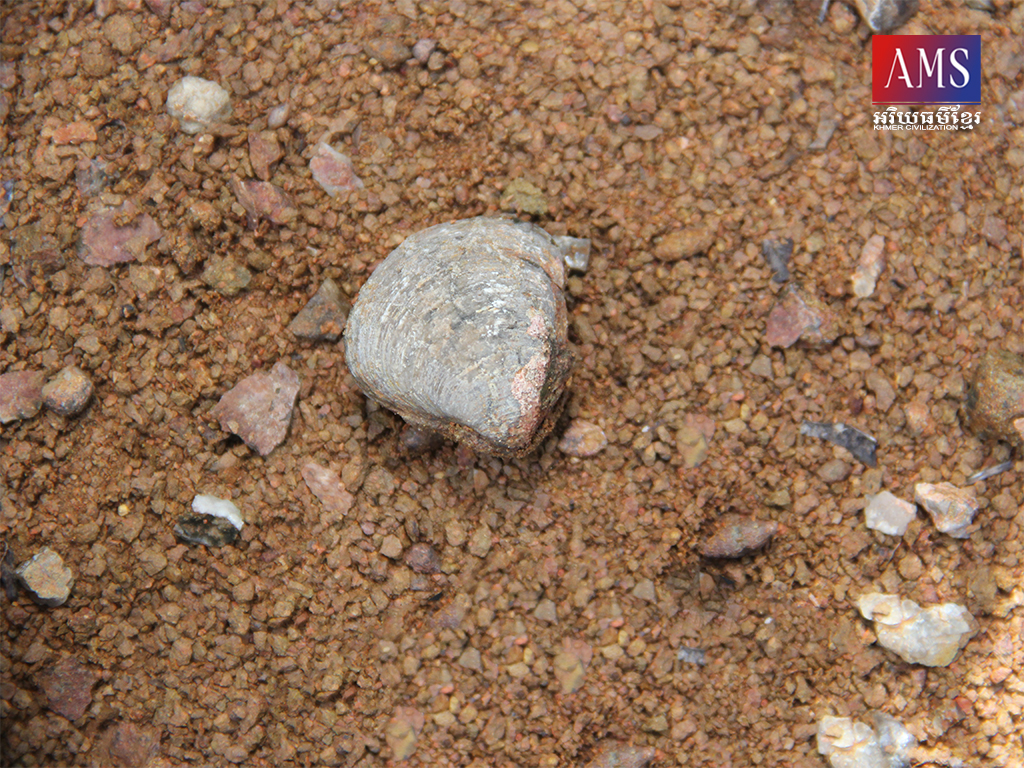ភ្នំកន្ទួតជាស្ថានីយផូស៊ីលសត្វសមុទ្រមួយ ដែលមានទីតាំងភូមិសាស្រ្តជាប់នឹងភ្នំស្វាយ ស្ថិតនៅក្រុងសិរីសោភណ្ឌ ខេត្តបន្ទាយមានជ័យ។ ប្រសិនយើងចង់ទៅដល់ទីតាំងភ្នំកន្ទួត គឺត្រូវធ្វើដំណើរតាមផ្លូវបេតុង ខាងកើតសាលាខេត្តបន្ទាយមានជ័យ នោះយើងនឹងឃើញមានផ្លូវបត់ឆ្វេងឡើងទៅកាន់វត្តភ្នំស្វាយ និងភ្នំកន្ទួតជាក់ជាពុំខាន (រូបលេខ១)។ ភ្នំកន្ទួតជាប្រភេទភ្នំថ្មកំបោរ ដែលកកជាស្រទាប់ៗ លាយនឹងស្រទាប់ដីដែលមានអតីតកាលជា សមុទ្រមានអាយុកាលក្នុងស័កទី១ សម័យ Permian (២៥១-២៩៩លានឆ្នាំ)។ នៅកំឡុងឆ្នាំ២០២០ ក្រុមការងារសិក្សាស្រាវជ្រាវផូស៊ីល នៃនាយកដ្ឋានតំបន់បេតិកភណ្ឌ បានចុះសិក្សាស្រាវជ្រាវ និងប្រមូលទិន្ន័យ ដោយបានប្រទះឃើញមានសំណាកផូស៊ីលជាច្រើននៅទីតាំងភ្នំកន្ទួតនេះ។ សំណាកផូស៊ីលទាំងនោះរួមមាន៖
ប្រភេទផ្កាថ្មស្នែងដែលយើងបានរកឃើញនៅទីនោះ។ ផ្កាថ្មប្រភេទនេះក៏បានរកឃើញនៅស្ថានីយផូស៊ីលភ្នំបាក់ដែលស្ថិតនៅក្នុងជម្រៅជ្រៅមួយ ហើយក៏បានរកឃើញនៅភ្នំព្រះភ្នំវែងផងដែរ។ ប្រភេទផ្កាថ្មស្នែងស្ថិតនៅក្នុង Phylum Cnidaria, Class Anthozoa, Rugosa Corals ពពួកនេះមានប្រវត្តិរីកចំរើននៅក្នុងស័កទី១ Paleozoic ដែលស្ថិតនៅក្នុងចន្លោះពី ៤៥០លានឆ្នាំ បន្តមកដល់ចុងសម័យ Permian មានអាយុកាល២៥១លានឆ្នាំ និងមាននៅសល់តិចតួចបន្តមកពេលបច្ចុប្បន្ន។
២. ប្រភេទមួយនេះវាមិនមានភាពច្បាស់លាស់នោះទេ វាអាចជាផ្កាថ្ម ឬសារាយ។ ខ្ញុំគិតថាវាក៏ជាប្រភេទមួយរបស់ផ្កាថ្មដែរ វាមានដើមតូចៗ ដែលប្រហាក់ប្រហែលនិងពពួក Tabulate Corals, Class Anthozoa, Phylum Cnidaria ពពួកនេះយើងក៏ធ្លាប់ជួបប្រទះនៅស្ថានីយផូស៊ីលភ្នំបន្ទាយនាង និងភ្នំកងវ៉ាផងដែរ។
៣. ជាបំណែកមួយនៃពពួកផ្កាថ្ម ដោយមានការកកបាំងផ្នែកដែលចេញរូបរាងវា យើងអាចដឹងថាវាជាប្រភេទមួយ នៅក្នុង Sub-class Scleractinia, Class Anthozoa, Phylum Cnidaria។ ពពួកដែលមានលក្ខណៈប្រហាក់ប្រហែលនេះមានជួបនៅស្ថានីយផូស៊ីលសត្វសមុទ្រ ភ្នំបន្ទាយនាង ភ្នំកងវ៉ា ភ្នំបាក់ ដែលមានភាគច្រើននៅស្រទាប់ខាងលើនៃភ្នំ។
៤. ចំពោះពពួកខ្យង គឺវាមានលក្ខណៈស្រដៀងទៅនឹងខ្យងក្នុងពេលបច្ចុប្បន្ន។ ពពួកខ្យងប្រភេទនេះ គឺមានតាំងពីយុគសម័យ Paleozoic Gastropoda ដែលស្ថិតនៅក្នុង Family Lophospiridae, Class Gastopoda, Phylum Mollusca តែយើងក៏មិនទាន់អាចកំណត់ថាវាមានឈ្មោះអ្វីនៅឡើយទេ។
៥. ពពួកខ្យងមួយប្រភេទទៀតដែលនៅក្នុងយុគសម័យ Paleozoic Gastropoda ដែលខ្ញុំបានជួបប្រទះនោះ មានរាងមូលស្ទើរដូចកូនបាល់ បច្ចុប្បន្នខ្យងប្រភេទនេះពុំឃើញមាននោះទេ។ ពួកនេះស្ថិតនៅក្នុង Family Bellerophontidae, Class Gasrtopoda, Phylum Mollusca។ ពពួកនេះខ្ញុំបានជួបប្រទះ នៅស្ថានីយ៍ផូស៊ីលសត្វសមុទ្រភ្នំបាក់ និងភ្នំស្វាយផងដែរ។
៦. ជាបំណែកនៃពពួក អាម៉ូនីត ពពួកនេះមានចាប់តាំងពីប្រមាណ៤០០លានឆ្នាំមក ប៉ុន្តែវាមានការរីកចំរើនតិចតួច និងមានច្រើននៅអំឡុងស័កទី២។ យើងបានជួបតែបំណែកតិចតួចតែប៉ុណ្ណោះ។ ខ្ញុំក៏មិនទាន់ដឹងថាវាមានឈ្មោះអ្វីនៅឡើយទេ តែវានៅក្នុង Family Ammonoidea, Class Cephalopoda, Phylum Mollusca។
៧. ពពួក Brachiopods មានឃើញនៅភ្នំនេះជាច្រើនប្រភេទដូចជា ជា៤ប្រភេទផ្សេងៗគ្នានៅក្នុង Phylum Brachiopoda។
៨. លាស នេះជាលើកដំបូងហើយ ដែលយើងប្រទះឃើញផូស៊ីលលាស ដោយមានសណ្ឋានស្រដៀងនឹងលាសបច្ចុប្បន្ន វាមានទំហំប៉ុនលាចទឹកសាបសព្វថ្ងៃ។ ដែលស្ថិតនៅក្នុង Phylum Mollusca Class Bivalvia។
៩. ផូស៊ីលពពូក Crinoid ត្រូវបានកកក្តាំងទៅជាថ្មកំបោរ និងអាចលាយឡំនឹងសត្វផ្សេងៗទៀត។
រួមសេចក្តីមកទីតាំងភ្នំកន្ទួតបានបង្ហាញអំពីភស្តុតាងផូស៊ីលជាច្រើន ក្នុងពេលដែលប្រទេសកម្ពុជាស្ថិតនៅក្រោមសមុទ្រនៅឡើយ។ ហើយវាមានអាយុកាលក្នុងសម័យ Permian (២៥១-២៩៩លានឆ្នាំ) នាស័កទី១។ ទីតាំងនេះគួរជាទីទាំងដែលមានតម្លៃសម្រាប់ការសិក្សាស្រាវជ្រាវបែបវិទ្យាសាស្ត្រ ស្តីអំពីជីវៈចម្រុះក្នុងសមុទ្រសម័យបុរាណ និងការអភិរក្សបេតិភណ្ឌធម្មជាតិរបស់ប្រទេសកម្ពុជា។
———————————
Phnom Kantuot Marine Fossil Site
Phnom Kantuot is a marine fossil site located geographically next to Phnom Svay in Serey Sophorn City, Banteay Meanchey Province. To reach Phnom Kantuot, take the concrete road east of Banteay Meanchey Provincial Hall, we will see Wat Phnom Svay and Phnom Kantuot for sure on the left side.
Phnom Kantuot is a type of limestone mountain that is congealed in layers mixed with the soil layer that was marine in the past, 1st era of the Permian period (251-299 million years). During the year 2020, the fossil study team of the Department of Heritage sites conducted research and data collection, found a number of fossil specimens in this mountain. These fossil specimens include:
Horned coral (Figure 2) is in Phylum Cnidaria, Class Anthozoa, Rugosa Corals. It has a history of growing in the 1st era of Paleozoic period, which in between 450 million years and the end of the Permian period, is 251 million years old and there are less survived till today. This type of coral was also found at the Phnom Bak fossil site in a deep depth and also found at Phnom Preah Phnom Veng.
(Figure 3) One such discovery is not clear, it could be coral or algae. I think it is also a kind of coral, it has small stems that are similar to Tabulate Corals, Class Anthozoa, Phylum Cnidaria, these species we have also encountered at the fossils site of Phnom Banteay Neang and Phnom Kang Va.
(Figure 4) Other species of coral which we can identify that is specified in species of the sub-class Scleractinia, Class Anthozoa, Phylum Cnidaria. These species are similarly found at the Banteay Neang, Phnom Kang Va, and Phnom Bak, which are mostly in the upper layer of the mountain.
Snail species (Figure 5) are similar to snails today. These species have been contained since the Paleozoic Gastropoda era within the Family Lophospiridae, Class Gastopoda, Phylum Mollusca, but we can not yet determine its name.
Another species of snail in the Paleozoic Gastropoda era that I encountered was almost round shape like a ball. Currently, this species is not found, they are in the Family Bellerophontidae, Class Gasrtopoda, Phylum Mollusca. I also encountered these at the fossil site of Phnom Bak and Phnom Svay.
(Figure 7) Pieces of ammonite species have survived for about 400 million years, but have been little grown and there were many during the 2nd era. We only found a few pieces. We do not know its name yet, but it is identified as in Family Ammonoidea, Class Cephalopoda, Phylum Mollusca.
Brachiopods can be found on this mountain in many species, there were four different species in the Phylum Brachiopoda era. Clam is the first time that we have seen a fossil with a shell similar to the current one, it is about the size of a freshwater clam shell today, in the Phylum Mollusca Class Bivalvia.
Crinoid fossils are congealed to limestone with other animal fossils.
អត្ថបទដើម៖ លោក លឹម វណ្ណច័ន្ទ











